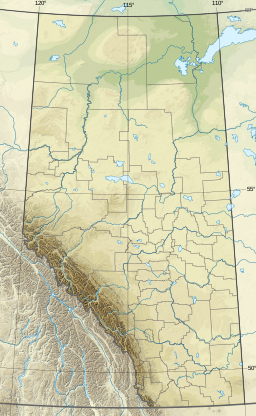geo.wikisort.org - Reservoir
Abraham Lake, also known as Lake Abraham, is an artificial lake and Alberta's largest reservoir. It is located in the "Kootenay Plains area of the Canadian Rockies' front range", on the North Saskatchewan River in western Alberta, Canada.[1]
| Abraham Lake | |
|---|---|
 Lake on the North Saskatchewan River | |
 Abraham Lake | |
| Location | Clearwater County, Alberta |
| Coordinates | 52°13′25″N 116°25′38″W |
| Type | Reservoir |
| Etymology | Silas Abraham |
| Primary inflows | North Saskatchewan River |
| Primary outflows | North Saskatchewan River |
| Basin countries | Canada |
| Max. length | 32 km (20 mi) |
| Max. width | 3.3 km (2.1 mi) |
| Surface area | 53.7 km2 (20.7 sq mi) |
| Max. depth | 4,335 ft (1,321 m) (above sea level) |
| Surface elevation | 1,340 m (4,400 ft) |
Description
Abraham Lake has a surface area of 53.7 km2 (20.7 sq mi) and a length of 32 km (20 mi).[2] Although man-made, the lake has the blue color of other glacial lakes in the Rocky Mountains, which is caused by rock flour.[3]
Abraham Mountain, Elliott Peak, and the Cline River Heliport are located on the western shore of the lake. Mount Michener is situated on the eastern shore. Mount Ernest Ross lies at the southern tip of the lake.
History
Abraham Lake was created by the former Calgary Power Company, now TransAlta, in 1972, with the construction of the Bighorn Dam.[4] Planning of the dam involved no evaluation of the social and environmental effects it may have caused and no public hearings were held prior to the construction. Construction of the Bighorn Dam flooded the Kootenay Plains and stopped the livelihood (hunting and fur trapping) of the Bighorn band of the Stoney Nakoda First Nation that had lived in that area. It had flooded their cabins, graves and pastures.[5]
The lake was built on the upper course of the North Saskatchewan River, in the foothills of the Canadian Rockies, and lines David Thompson Highway between Saskatchewan River Crossing and Nordegg.
The Government of Alberta sponsored a contest to name the lake in February 1972, during the final stages of construction of the Bighorn Dam. Students across the province were asked to submit names taking into consideration "historical significance, prominent persons, geography and topography, and the value of the lake."[6] It was eventually named after Silas Abraham (c. 1870–1964), of the Stoney Nakoda First Nation and originally from Morley, Alberta.[7] He was farmer and hunter who lived in the Kootenay Plains and later on the Big Horn 144A reserve.[8][9]

Phenomenon

Trapped methane causes frozen bubbles to form under the ice on the lake's surface. This phenomenon results when decaying plants on the lake bed release methane gas, which creates bubbles that become trapped within the ice, in suspended animation, just below the surface as the lake begins to freeze. The visual effects formed by the resulting stacks of bubbles, frozen while rising toward the surface, combined with the clear blue water, have made Abraham Lake a popular destination for photographers and nature observers.[10][11] The ice coverage of the lakes varies throughout the winter. It usually freezes by the end of December but did not freeze until January in 2020.
See also
- Lakes of Alberta
References
- "Abraham Lake". lakelubbers.com. Raub's Internet for Business, LLC. Archived from the original on 5 September 2017. Retrieved 11 March 2019.
- "Abraham Lake - Ice Bubbles and More..." David Thompson Country. 30 October 2020. Archived from the original on 2 November 2020. Retrieved 4 April 2021.
- "Abraham Lake, Alberta, Canada Vacation Info". Lakelubbers. Archived from the original on 24 February 2013. Retrieved 4 April 2021.
- "Abraham Lake". lakelubbers.com. Archived from the original on 5 September 2017. Retrieved 11 March 2019.
- Ross, Thomas E. (10 April 2019). A Cultural Geography Of North American Indians. Routledge. ISBN 978-0-429-71275-3. Archived from the original on 12 June 2022. Retrieved 9 February 2021.
- The Edmonton Journal, 16 February 1972
- "Noted Indian Visits Stelfox". Edmonton Journal. 13 September 1960. Archived from the original on 12 June 2022. Retrieved 4 April 2022.

- "Silas Abraham, 'Gentle hunter of the Kootenay Plains'". Red Deer Advocate. 12 May 1972. Archived from the original on 12 June 2022. Retrieved 4 April 2022.

- "Abraham Lake". Travel Nordegg. Archived from the original on 24 May 2012. Retrieved 3 September 2006.
- "Frozen Bubbles Suspended Below Abraham Lake". My Modern Met. 27 December 2012. Archived from the original on 29 December 2012. Retrieved 4 April 2021.
- "Abraham Lake". lakelubbers.com. Archived from the original on 24 February 2013. Retrieved 4 April 2021.
External links
 Media related to Abraham Lake at Wikimedia Commons
Media related to Abraham Lake at Wikimedia Commons
На других языках
[de] Abraham Lake (North Saskatchewan River)
Der Abraham Lake ist ein Stausee des North Saskatchewan River im Clearwater County im Westen der kanadischen Provinz Alberta. Er ist der größte künstlich angelegte See in Alberta.- [en] Abraham Lake
[fr] Lac Abraham
Le lac Abraham, en anglais : Abraham Lake, est un lac artificiel sur la rivière Saskatchewan Nord à l'ouest de l'Alberta au Canada. Le lac Abraham a une superficie de 53,7 km2 et une longueur de 32 km.[it] Lago Abraham
Il lago Abraham è un bacino artificiale sul fiume North Saskatchewan nella provincia canadese dell'Alberta, Canada. Ha una superficie di 53.7 km² e una lunghezza di 32 km.[ru] Эйбрахам
Эйбрахам (англ. Abraham Lake) — водохранилище, созданное в 1972 году при строительстве плотины на реке Норт-Саскачеван в западной Альберте, Канада. Площадь — 53,7 км². Расположено на высоте 1340 метров и имеет максимальную длину 32 км, а ширину до 3,3 км, — являясь крупнейшим водоёмом на равнине Кутеней[1].Другой контент может иметь иную лицензию. Перед использованием материалов сайта WikiSort.org внимательно изучите правила лицензирования конкретных элементов наполнения сайта.
WikiSort.org - проект по пересортировке и дополнению контента Википедии
